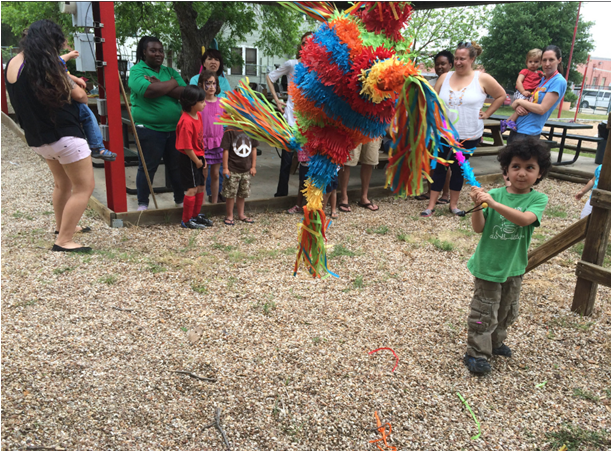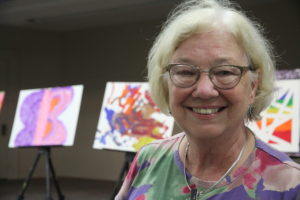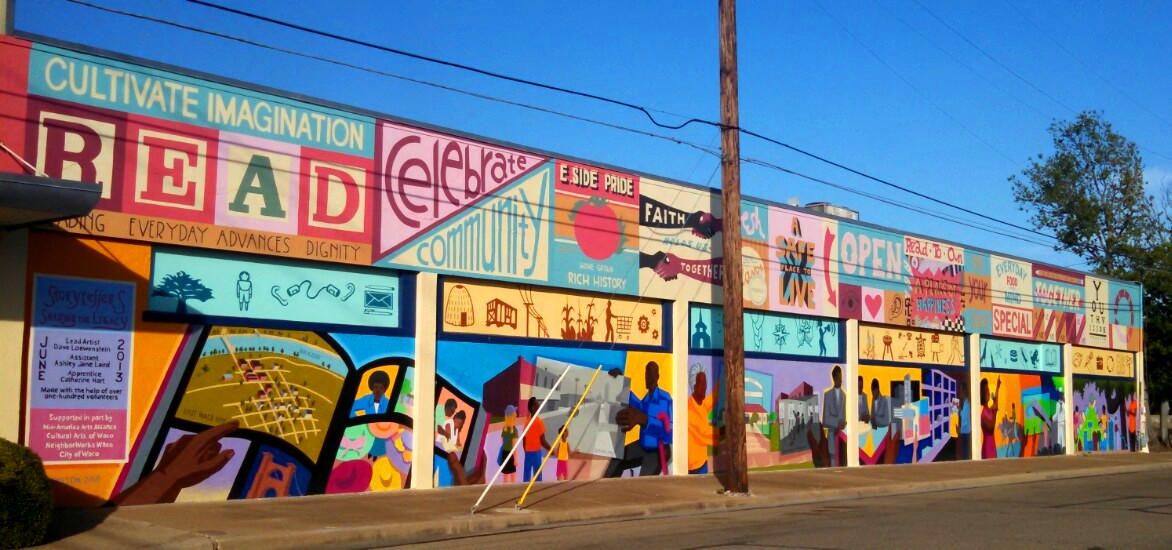by Fernando Arroyo
She was only four feet tall. But, with a grip like a vice, she yanked at my arm while scolding me — in Mayan, in a voice that would rival Chef Gordon Ramsay of “Kitchen Nightmares” fame — to immediately stop stirring the pot of maize that was simmering on the open fire in front of me. I was learning about the roots of my Mexican indigenous culture, and evidently I was not a very good student. I had only ONE JOB, to stir the pot, and I couldn’t do it right! My eyes searched one of the many one-room, thatched-roof huts that dotted the village as I looked desperately for my professor who grew up in this village and was my translator.
The translation was, “You’ll spoil it! We must take great care in how we do this. Every step of the meal matters. Stir the maize in one direction. If you start stirring in the opposite direction, you will undo the care, work and energy that began in the stirring of the pot. Only one direction next time. Give it to me!”
Even though I did not master that art of making campfire joloch tamales that day, the instruction and wisdom I gleaned from the little Mayan chef was far more profound. She gave me eyes to see the wonder in our ordinary actions. I was struck by how even the most seemingly ordinary tasks and processes of the community had an incredible significance and power within them.
How do I use my new eyes at home in my own neighborhood? Through sharing.
I decided to discover my neighbors’ stories and to share my own. In doing so I found that creative energy and radical acts of kindness cascade from our neighbors and surge through our streets, parks, buildings and yards. In my neighborhood, Sanger Heights, strangers and friends are joining to share life, resources and transformation. Shareable.net describes what I see and hear in my neighborhood:
“When individuals embrace sharing as a worldview and practice, they experience a new, enlivening way to be in the world. Sharing heals the painful disconnect we feel within ourselves, with each other, and the places we love. Sharing opens a channel to our creative potential. Sharing is fun, practical, and perhaps most of all, it’s empowering. It enables us to experience and do things we never thought possible.”
Most of these kinds of connections are not begun by programs or institutions but by decentralized and self-organized groups stepping out to be intentional neighbors. Here are some experiments that my family and I have tried to expand our sharing opportunities:
Toy Swaps — I exchanged some toys collecting dust with new-to-the-Arroyo-kids toys at no other cost.
Clothing Swaps — We de-cluttered our closet and got a new wardrobe exchanging clothes in good condition
Meal-sharing — I cooked four casserole dishes with spaghetti and froze them. During a swap night with other families, I traded three of my frozen dinners for three different ones. Bam! I had three heat and ready-to-eat unique dinners I didn’t have to cook.
Car-sharing — Some friends are eschewing purchasing individual vehicles and instead are sharing a car, a van, and a truck. They share the maintenance costs and save themselves the full expense of vehicle ownership. Plus, they decrease their gas use and car pollution.
Cow-sharing — For the last two years, my friend and I have shared the purchase of a grass-fed cow from World Hunger Relief, Inc. A quarter of Rico the Cow fed my family for a year!
Do-It-Ourselves Education — On Tuesdays, my children and I meet up with other families from inside and outside the neighborhood to build balloon rockets, conduct archaeological digs, investigate erosion principles, and much more. On Fridays, I co-lead a neighborhood Spanish-exposure time helping children and their parents fall in love with languages, especially Spanish, my native tongue.
Peer-to-Peer Lending — Congregation members of a local church called Hope Fellowship are experimenting in lending to one another at zero percent interest as a way to disrupt the negative debt cycles crated by Cash-Advance/Payday Lending institutions and to invest in one another instead of the financial markets alone. This idea and practice was inspired by theologian Ched Myer’s Sabbath Economics series. Members of this project, called the Mustard Seed Fund, are excited about sharing the good news of supplemental economic systems that value people and places over profits.
Nuestra Voz Open Mic Night — Artists, musicians, poets, writers and more gather the second Saturday of every month at 7PM at The Art Forum of Waco (1826 Morrow) to share their stories and create space for good ol’ fashioned “analog” social networks. I co-founded this event in partnership with Jenuine Poetess from Word Around Waco, and the Art Forum of Waco.
Halloween On Colcord — Ghosts, Ghouls, and Goblins from all walks of life gather to enjoy the sights, sounds and candy at this yearly neighborhood event. Last year over a thousand hotdogs were devoured. Neighborhood churches, organizations, and groups host front yard activities. Contact me if you are interested in hosting a yard or an activity.
Sanger-Heights Neighborhood Association — I’m on the board. We’re working on ways to boost our neighborhood economy. We are conspiring to help create celebrations that represent our neighbors’ stories like Dia de los Niños and more. We are developing our 501(c)3 status and laboring together to help repair our sidewalks and our homes that are layered with history and culture.
According to Robert Sampson’s Great American City, the most resilient and cohesive neighborhoods, where neighbors take joy in the life of the neighborhood, are those where neighbors know one another and know that those around them will help in their time of need. In other words, people love their neighborhoods when they know each others’ stories and are there for one another when things go down.
Live these stories with me…or live into the ones in your own neighborhood. Move your barbecue pit and lawn chairs from your fenced-in backyard to the front yard and share a meal with a stranger or a new friend down the street. For a more enriching experience, share that meal with folks from another faith tradition, financial bracket, or cultural experience.
We are all social beings and our relationships and places make us who and what we are. Become an active part of one anothers’ stories. In the process, you too will receive new eyes to experience the exquisiteness of love and life in your place.
What kinds of stories do you see in your neighborhood? Share your stories in the comments. Contact me for more information.
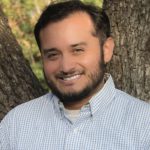 This blog post was written by Fernando Arroyo. Fernando migrated from the Yucatan Peninsula to Waco and lives in the Sanger-Heights Neighborhood with his wife/best friend, three young children, (too many) ornery chickens, his wire-haired dog, and delightful neighbors. He works as a corporate instructor with Temple College and McLennan Community College teaching courses in workforce development, technology, leadership and management. Fernando’s experience includes being on staff and on the board of a number of nonprofit and for-profit organizations improving affordable housing, youth violence reduction, youth entrepreneurship, immigrant advocacy, public and private education, and community and economic development. He holds a Bachelor’s degree from Baylor University and a Master’s from Concordia University. His mission is to serve as a catalyst for peace, healing, justice, and reconciliation. Contact him at lfarroyo@gmail.com. The Act Locally Waco blog publishes posts with a connection to these aspirations for Waco. If you are interested in writing for the Act Locally Waco Blog, please email ashleyt@actlocallywaco.org for more information.
This blog post was written by Fernando Arroyo. Fernando migrated from the Yucatan Peninsula to Waco and lives in the Sanger-Heights Neighborhood with his wife/best friend, three young children, (too many) ornery chickens, his wire-haired dog, and delightful neighbors. He works as a corporate instructor with Temple College and McLennan Community College teaching courses in workforce development, technology, leadership and management. Fernando’s experience includes being on staff and on the board of a number of nonprofit and for-profit organizations improving affordable housing, youth violence reduction, youth entrepreneurship, immigrant advocacy, public and private education, and community and economic development. He holds a Bachelor’s degree from Baylor University and a Master’s from Concordia University. His mission is to serve as a catalyst for peace, healing, justice, and reconciliation. Contact him at lfarroyo@gmail.com. The Act Locally Waco blog publishes posts with a connection to these aspirations for Waco. If you are interested in writing for the Act Locally Waco Blog, please email ashleyt@actlocallywaco.org for more information.
by Jenuine Poetess
“The first move from chaos isn’t order—it’s creativity. In murals, music, theaters, cafes, and poetry. It comes from within people, within families, within community. It rises from the hunger people have for knowledge, ideas, and stories.” ~ Luis J. Rodriguez
There is a need, within all of us, to be known. A longing to be seen, be heard, be understood. Across all of time, arts and culture have served as a catalyst for this most fundamental aspect of our beings, of our becomings.
Join me as I explore Waco’s rich community of visionary artists transforming, awakening, and inspiring individuals and their neighborhoods. My mission, as facilitator of Act Locally Waco’s newest blog series on Arts & Culture, is to show you—in such a myriad of vibrant hues—the thrilling work being done here and the extraordinary individuals giving their time and talents to our city!
Last week I sat down with Doreen Ravenscroft, founder and director of Cultural Arts of Waco . I have the utmost respect and admiration for her vision, her creativity, and her unwavering dedication to making arts, cultural, and opportunities for creative expression accessible to individuals of every age, ability, gender, culture, belief, class, and language.
Originally from the United Kingdom, Doreen moved to Waco in 1978 when her late husband Bill, was transferred to the M & M Mars US division. Here she became a part of the Open Door Arts Festival and when that project come to a close, she founded the Cultural Arts of Waco believing in the importance of continuing free, community arts opportunities. This vision gave birth to the Waco Cultural Arts Festival which is now celebrating it’s 11th year and has grown into five flourishing festivals in one.
In her own practice, Doreen most enjoys painting in a large scale such as murals and faux finishing walls in addition to taking in theater, gallery shows, and live music. She is constantly nourishing her creative aspects and brainstorming ways to enrich Waco’s arts and culture offerings.
The Cultural Arts of Waco was granted the only Texas award from the Mid-America Arts Alliance in June 2013. This award funded the creation of the mural on the East Waco branch of the McLennan County Library. For several weeks leading up to the painting, artists gathered with community members to dialogue and draft the vision for this mural. Doreen organized the team of artists as well as the collaboration with neighborhood residents remembering, “It was so fabulous to learn so much more about everyone who lives in East Waco and all those little special anecdotes that only they could give to this project.”
I took a drive by that mural again after I met with Doreen; a visit I like to make pretty regularly. There are so many facets and stories within the mural I relish each time I spend with it.
As I was enjoying this gorgeous canvas, a man also paused to take it in. We chatted for a moment and agreed how lovely it is. I asked if he helped paint it, with a spark of pride and honor he said, “No, I didn’t. But I know people who painted this, they’re my neighbors and friends. I take this street to the bus stop, just so I can walk by here and look at it.”
This is the power of art. In community, for community, by the community. Accessible collaborations for all. I was moved, deeply, by this man’s pride and ownership of this public artwork. It means so much more than a brightly colored building in his neighborhood.
Doreen has an number of dynamic projects on her easel at the moment the grandest of which is the Waco Cultural Arts Festival happening September 26-28th at Indian Spring Park and Waco Convention Center. This free, three-day, community event for all ages offers art activities, concerts, performances, workshops, panel discussions, open mics, poetry slam, and film screenings from across the five festivals which include {254}DanceFest, ScienceFest, Celebration Africa FilmFest, WordFest, and the Main Stage MusicFest . Kicking off the festival weekend is the Annual White Linen pARTy featuring music by Guy Forsyth and the Hot Nut Riveters, a sneak peek at the {254}Dance-Fest, and ScienceFest Chair and visual artist, Erica Wickett. The White Linen pARTy is one of the key fundraising events for the Cultural Arts of Waco.
Toward the end of our conversation, I asked Doreen what her hopes are for Waco. I listened as she dreamed,
“I hope for Waco to heal wounds of its past, between its different communities. Arts help express what can’t always be said, it reveals our hurts, and provides space for understanding. I long to see more safe spaces where children and elders and individuals across every generation and ethnicity can gather around creative projects fostering curiosity, without barriers. And through that curiosity, begin to share and to listen to each other’s stories.”
 Jenuine Poetess is an artist, visionary, and community organizer. In 2010, she founded In the Words of Womyn (ITWOW), an international, grass-roots, written and spoken-word arts project with chapters throughout Los Angeles; Waco, TX; and Lebanon. ITWOW empowers womyn of all ages to give sound to our story and volume to our voice. Jenuine also co-hosts Nuestra Voz & Word Gallery, monthly open mic venues for poetry, music, spoken-word, story-telling, and more! You can contact her at: jenuinepoetess@gmail.com.
Jenuine Poetess is an artist, visionary, and community organizer. In 2010, she founded In the Words of Womyn (ITWOW), an international, grass-roots, written and spoken-word arts project with chapters throughout Los Angeles; Waco, TX; and Lebanon. ITWOW empowers womyn of all ages to give sound to our story and volume to our voice. Jenuine also co-hosts Nuestra Voz & Word Gallery, monthly open mic venues for poetry, music, spoken-word, story-telling, and more! You can contact her at: jenuinepoetess@gmail.com.
by Phil York
Football season is here. As an Aggie transplant to Waco, I have a new struggle: competing loyalties as I slowly learn to cheer for my new home team, Baylor University.
On August 28th, the Family Health Center auditorium was buzzing with the energy of a packed football stadium on the Brazos. But, unlike a crowd that is divided by team loyalties, this audience was united by a powerful bond.
More than 80 Wacoans met under the leadership of Citizens for Responsible Lending (CRL), a group established this year by and for Wacoans for the purpose of advocating for an economically healthy Waco. The event was dubbed, “The State of Pay Day Lending Rally.”
Robin Reid spoke first at the Rally. Robin was the true expert in the room: she took out a pay day loan several years ago and had the courage to share her personal story with us. Robin reminded us that pay day loans provide an important service that is not provided by traditional banks. However, predatory practices such as intimidating phone calls at her home and workplace, automatic renewals, and exorbitant fees are not acceptable. As Robin highlighted, the discussion that night was not about being anti-business; but about being pro-good business.
After Robin, representatives from CRL (Alexis Christensen, Ryn Farmer, Rucker Preston and Josh Caballero), Texas Appleseed (Ann Baddour), and Texas Catholic Conference (Jennifer Carr Allmon) provided an update about Pay Day lending on the national, state and local levels. Together, the presenters answered several important questions, including these:
- Why should we care about pay day lending in Waco?
- What further steps can you take about pay day lending?
Why should we care about pay day lending in Waco?
 We should care about Pay Day lending because of the negative impact it has on our local economy. Pay Day lending is a big presence in Waco. Waco has 29 licensed Pay Day Loan/Title Loan storefronts. That is more than the total number of McDonalds (8) and Starbucks (5) combined! Under the current laws that do not limit fees, size of the loan, rollovers or refinances, and do not consider the ability to repay based on income, Pay Day lending is a big loser for the Waco community.
We should care about Pay Day lending because of the negative impact it has on our local economy. Pay Day lending is a big presence in Waco. Waco has 29 licensed Pay Day Loan/Title Loan storefronts. That is more than the total number of McDonalds (8) and Starbucks (5) combined! Under the current laws that do not limit fees, size of the loan, rollovers or refinances, and do not consider the ability to repay based on income, Pay Day lending is a big loser for the Waco community.
Here are a few facts to give you a sense of the economic impact:
- Borrowers pay an average of $23 in fees every 2-4 weeks for every $100 borrowed. Installment payday borrowers pay about $100 in fees per $100 borrowed.
- 602 cars were repossessed last year by auto title lenders in the Waco area. To put that in perspective, there are 1,900 parking spaces available in downtown Waco for Baylor Football games. Imagine the cars in almost a third of those spaces being repossessed and their drivers left without transportation to get to work or to take care of the other necessessities of life.
- 10.5 million dollars were drained from the Waco area economy in 2013 because of excessive fees.
What further steps can you take about Pay Day lending?
Join us! – This powerful rally was the result of concerned Wacoans coming together. When I spoke to Jennifer of the Texas Catholic Conference after the rally, she commented that Waco is one of the most proactive and caring communities she has visited in her Texas-wide research. Whereas other communities need extra support, Wacoans boldy say “we got this!” You can join your neighbors and friends who are already part of Citizens for Responsible Lending (CRL). Contact Alexis Christensen at alexis@wacocdc.org or 254-235-7358 to learn more.
Know your rights – Organizations such as the Texas Rio Grande Legal Aid provide literature about pay day lending. If you or some of your friends and family are already ensnared in debt related to Pay Day or Title lending, one of the most powerful tools for reducing the negative effect is to know your rights. Here are two helpful bulletins:
Share your opinion with the Waco City Council – At the rally, Council Member Toni Herbert (District 4) reminded us that there is a designated item on each Council meeting agenda called “hearing of visitors.” This is time specifically set aside for citizens to have a chance to voice concerns. You could use this time to voice your concerns about Pay Day lending. Council meetings are held the first and third Tuesdays of every month. Here’s a link to more information about how our city council works: Waco City Council.
Sign the petition supporting a Waco City Council resolution about Pay Day Lending – The Citizens for Responsible Lending have drafted a resolution that we would like for the Waco City Council to adopt. If adopted, it would state that our city council resolves to:
- Urge the Texas Legislature and Governor of Texas to adopt a 36% annual percentage cap on fees/interest,
- Encourage the City of Waco to explore alternatives and ordinances,
- Follow the same format of cities such as Bryan and College Station that passed ordinances. Currently. (18 cities have passed ordinances)
If you would like to sign the petition urging our city council to adopt this resolution, contact alexis@wacocdc.org.
Alas, football season is here.
Football seasons have winners and losers, and they come and go. Some seasons are filled with “band-wagoners” who follow in the wake of the winning team. Unlike the fickle nature of football followership, the diligent passion, care and concern of Wacoans is as constant as the river Brazos.
Robin Reid’s story is our story. Predatory lending practices that threaten the financial security of many Waco residents are a concern for all Waco residents. These practices threaten the economic health of our whole community by preying on residents who are working hard to gain a financial foothold. We know how to join hands and act locally to insist on fair, pro-good business practices, and that is exactly what we are doing.
 Phil York, Director of Development at Waco Habitat for Humanity, is a self-described “policy nerd;” he is also the Act Locally Waco housing and homelessness policy blogger. You can direct questions to Phil to pyork.law@gmail.com. Would you be interested in blogging for Act Locally Waco? If so please email ashleyt@actlocallywaco.org.
Phil York, Director of Development at Waco Habitat for Humanity, is a self-described “policy nerd;” he is also the Act Locally Waco housing and homelessness policy blogger. You can direct questions to Phil to pyork.law@gmail.com. Would you be interested in blogging for Act Locally Waco? If so please email ashleyt@actlocallywaco.org.
By Liz Ligawa
The previous month had closed its doors, taking along with it the security of minor accomplishments. Rent: paid. She had grown to appreciate such victories as they were hard won; however, they rarely lingered long. This life still felt odd to her- the newly poor. She was not yet adept at balancing the weight of a community’s conclusions concerning the economically poor. She struggled against this label. At any rate, she still found herself at this uncomfortable threshold- the bewitching hour, if you will. This is the place where settled becomes uncertain. Done becomes undone. Exclamations curl into question marks. The place when the clock strikes midnight…the first day of the month.
Responding to a prompt the other week at In The Words of Womyn Writing Circle, I explored the factors that pigment how we see one another. We have all done it before – created a backstory to a situation with little, or no information. For instance, take the couple in the car idling next to yours at the red light. The conversation seems quite animated. It is easy to create an entire commentary based on just what is seen. We think they are in an argument, or maybe perhaps it’s charades…yes, definitely charades. But can we get the real picture without words? The ways we interpret what we see in the world and the ways we determine how we should respond to others come to us through pipelines which preceded our generation, our nation, and even our society. One woman’s story shows us how.
She slowly left the office which was connected to the place where God’s people gather, trying to shake the heavy haze of defeat from her mind. She had asked for aid. She was denied. This is not an unusual story, but she wondered what could have informed the greeter’s conclusion. Maybe it was her bare ring finger, freshly unadorned, yet still declaring her to be less than another whose finger resembled a more acceptable status. Maybe the problem was her empty hands whose emptiness looked more indolent than worn. It may have even been her accompanied left hip, sweetly occupied by a sleepy little one looking for a safe place to rest. What did the greeter see?
 There is a history to caring. My critical attention in Dr. Gaynor Yancey’s course, Urban Mission Issues, reminded me that societies have differed, historically, in their approach to meeting the needs of others. In Egyptian society, good deeds were recorded as Acts of Mercy in each person’s Book of the Dead. A fat Book of the Dead filled with Acts of Mercy was seen as contributing to a pleasant afterlife. This idea motivated the response to the needs of others. In the mother’s case above, however, declining to help her would still qualify as an Act of Mercy since it did not impose harm (Negative Confession). No need was actually met, but no harm was rendered. It sounds like parts of our current society are singing the same verse of a very old tune.
There is a history to caring. My critical attention in Dr. Gaynor Yancey’s course, Urban Mission Issues, reminded me that societies have differed, historically, in their approach to meeting the needs of others. In Egyptian society, good deeds were recorded as Acts of Mercy in each person’s Book of the Dead. A fat Book of the Dead filled with Acts of Mercy was seen as contributing to a pleasant afterlife. This idea motivated the response to the needs of others. In the mother’s case above, however, declining to help her would still qualify as an Act of Mercy since it did not impose harm (Negative Confession). No need was actually met, but no harm was rendered. It sounds like parts of our current society are singing the same verse of a very old tune.
Greek society demarcated the poor as either worthy, or unworthy. The “worthy poor” could receive care from the community; the unworthy poor were not as fortunate. Similarly, in Roman society, a person’s citizenship qualified him to receive from the community. This sole identifier served as an important indicator of determining the responsible party. Citizenship would answer this question, “Whose concern are you?”
As I listened to this mother, I saw reflections of these past societies intermingled with her story. The Negative Confession of the Egyptian society gives us the justification for “not doing”: not bringing harm, but neither bringing good. There is also the delineation of the Greek society making caring more necessary for one class of poor than the other. Then there are the remnants of the citizenship standard central to Roman society. I saw all of these in one story.
Now, we all have our reasons for giving, or choosing against giving. My interest does not concern imposing unnecessary feelings of guilt. I am, however, interested in calling attention to the motivations behind our giving, and maybe even encouraging some redistricting of our boundaries concerning who receives our care.
The mother thought about the greeter’s comment as she shuffled her little one into the seat: “I’m sorry, we can’t help you. Our resources are strictly for our members.” As she thought about the thousands of faces which gathered to worship in one of three services on Sundays, the mother wondered aloud, “She thinks I am not a member, but she didn’t even ask….”
The greeter had already created a backstory, and that informed her conclusion.
Just then, her little one softly questions, “Where are we going now, Mommy?” She does not know. Thirty seconds before this inquiry, she did. Now, she no longer does. She swallows hard and pushes shame aside long enough to smile down at the bright, waiting eyes, “Home.”
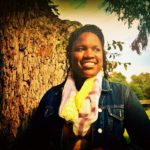 This post was written by Liz Ligawa. Liz is a graduate student of Baylor University where she has found the perfect expression of her community-centered heart in the MDiv/MSW degree program. With a concentration on Community Practice, she is also the adoring mother of one son, Elijah, who prefers to be regarded in public as Spider-Man. She may be reached at Liz_Ligawa@baylor.edu.
This post was written by Liz Ligawa. Liz is a graduate student of Baylor University where she has found the perfect expression of her community-centered heart in the MDiv/MSW degree program. With a concentration on Community Practice, she is also the adoring mother of one son, Elijah, who prefers to be regarded in public as Spider-Man. She may be reached at Liz_Ligawa@baylor.edu.
The Act Locally Waco blog publishes posts with a connection to these aspirations for Waco. If you are interested in writing for the Act Locally Waco Blog, please email ashleyt@actlocallywaco.org for more information.
.
by Julie Talbert
After being laid off from her first job, Doll Wilkerson spent time caring for her sick mother until she passed away. Earlier this year, she decided it was time to find a new job. Doll has a disability and thanks MHMR for helping her get hired at Big Lots. The final challenge for Doll was to figure out how to get home from work at night.
 Doll, who lives in north Waco, shares this challenge with as many as 26% of residents living in parts of north and east Waco who do not have access to vehicle. Waco Transit’s bus service stops running at 7:15 p.m., leaving many without a way to get to or from work at night.
Doll, who lives in north Waco, shares this challenge with as many as 26% of residents living in parts of north and east Waco who do not have access to vehicle. Waco Transit’s bus service stops running at 7:15 p.m., leaving many without a way to get to or from work at night.
For now, a solution exists. Doll was excited to learn about the Evening LINK; the first-ever evening transportation service available Monday – Saturday from 8:30 p.m. – 11:30 p.m. Evening LINK is a project of Workforce Solutions in partnership with Waco Transit and several other local agencies.
The Evening LINK is successfully addressing a growing need of residents working non-standard hours. Jobs in the food service, retail, health and medical, and manufacturing industries often require employees to work nights. The Evening LINK provides approximately 400 passenger trips a month using three vehicles and a reservation system to get workers in the greater Waco area to and from work safely, reliably, and affordably. Eighty percent of passengers are employed full time and 90% report that the service is extremely important to keeping their job. More than 60 businesses have employees who have used the Evening LINK.
Doll has been riding the Evening LINK five nights a week for the last three months. The service is helping her meet her goal of “living a healthy and independent life.” At 40, feeling independent is important to Doll and she expresses her excitement about her new life by saying, “My disability may slow me down, but it won’t stop me.”
 This Act Locally Waco blog post was written by Julie Talbert. Julie manages the child care and public transportation contracts for Workforce Solutions for the Heart of Texas. She believes that access to affordable, dependable and high-quality early education and public transportation systems are critical to a vibrant community. They are necessary to help us realize a vision of healthy children, strong families, and thriving economic opportunities.
This Act Locally Waco blog post was written by Julie Talbert. Julie manages the child care and public transportation contracts for Workforce Solutions for the Heart of Texas. She believes that access to affordable, dependable and high-quality early education and public transportation systems are critical to a vibrant community. They are necessary to help us realize a vision of healthy children, strong families, and thriving economic opportunities.
The Act Locally Waco blog publishes posts with a connection to these aspirations for Waco. If you are interested in writing for the Act Locally Waco Blog, please email ashleyt@actlocallywaco.org for more information.
by Kari Tingle
Before you continue reading this blog post, I’m going to ask you to do something out of the ordinary: I want you to go grab a piece of food. It can be anything you like, though I suggest you grab a whole food of some sort, like a piece of fruit or vegetable. Don’t eat it just yet.
I know some of you did not take me seriously, just like some of my students this summer! But I am quite serious. Go grab a snack. This post will be here when you get back.
Now that you have your snack of choice I want you to do a few things. First, look at your snack. What color is it? Does it have a rough or a smooth texture? Is it flexible, like spinach, or is it rigid, like a carrot? Does it have a particular shape? How would you describe its smell? Now I want you to take a bite, but don’t chew. Just hold that piece of food on your tongue. Does its texture feel different from when you held it in your hands? Use your tongue to move it around in your mouth – I know this seems strange, but I want you to get a good idea of what the food feels like. Now bite down slowly. How does the food taste? Is it sour or sweet? Is it creamy or crunchy? Is it a little slimy or sticky or spicy? If you can, take a minute to close your eyes and simply enjoy eating that snack.
 What you just did was practice mindful tasting, using all or most of your senses in the process of eating your food. I work as a Prevention Specialist at VOICE, an organization which seeks to bring lasting and positive change in the lives of the people with whom we work. This summer I was part of a pilot program in the Kate Ross public housing community in which we used an evidence-based curriculum to teach children how to live mindfully aware of their surroundings. Through a series of 15 lessons we focused on three major sections of the brain: the prefrontal cortex, the amygdala, and the hippocampus. We talked about how each of these parts of the brain guides the way we respond to certain situations. In addition to mindful tasting we practiced mindful seeing, mindful smelling, mindful listening, mindful movement, and being mindful of the way we interact with others. We sought, together, to choose optimism, to open ourselves to seeing things from another’s perspective, and to take moments to be thankful for the good things in our lives.
What you just did was practice mindful tasting, using all or most of your senses in the process of eating your food. I work as a Prevention Specialist at VOICE, an organization which seeks to bring lasting and positive change in the lives of the people with whom we work. This summer I was part of a pilot program in the Kate Ross public housing community in which we used an evidence-based curriculum to teach children how to live mindfully aware of their surroundings. Through a series of 15 lessons we focused on three major sections of the brain: the prefrontal cortex, the amygdala, and the hippocampus. We talked about how each of these parts of the brain guides the way we respond to certain situations. In addition to mindful tasting we practiced mindful seeing, mindful smelling, mindful listening, mindful movement, and being mindful of the way we interact with others. We sought, together, to choose optimism, to open ourselves to seeing things from another’s perspective, and to take moments to be thankful for the good things in our lives.
In addition to lessons we gathered each afternoon for a book club, meeting in the Kate Ross community center to work on reading skills. We used books that our curriculum suggested, books that helped to reinforce those lessons of mindful awareness. And, over the course of the summer, we witnessed real improvement in the reading comprehension of some of our students. We also spent Fridays at the Acts Church community garden, harvesting zucchini, onions, and potatoes while planting pumpkins, digging new rows, weeding the existing beds, and watering the plants. For us, mindful awareness included mindfully caring for the land we have been given.
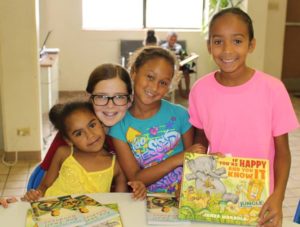 Before starting our program I wondered, “Is this actually going to work?” The curriculum was written for use in school classrooms, and we certainly were no school. We partnered with Acts Church. They generously provided wonderful volunteers for our reading club and they let us use the apartment they maintain within the Kate Ross housing complex. We taught our lesson in that apartment. Our gathering space was a living room, we served snacks from the kitchen, we held class in the bedrooms-turned-classrooms, and we had picnic-style lunches under tents in the common yard on days when there was no rain (which, this being Waco, means most days). There were times when the curriculum simply didn’t connect and we had to quickly improvise before the kids got antsy. There were other times when the curriculum connected so well it brought tears to my eyes because the kids were actually getting it. They were being mindful of themselves and of their surroundings and it was beautiful.
Before starting our program I wondered, “Is this actually going to work?” The curriculum was written for use in school classrooms, and we certainly were no school. We partnered with Acts Church. They generously provided wonderful volunteers for our reading club and they let us use the apartment they maintain within the Kate Ross housing complex. We taught our lesson in that apartment. Our gathering space was a living room, we served snacks from the kitchen, we held class in the bedrooms-turned-classrooms, and we had picnic-style lunches under tents in the common yard on days when there was no rain (which, this being Waco, means most days). There were times when the curriculum simply didn’t connect and we had to quickly improvise before the kids got antsy. There were other times when the curriculum connected so well it brought tears to my eyes because the kids were actually getting it. They were being mindful of themselves and of their surroundings and it was beautiful.
Our work this summer was work worth doing. Our students looked forward to learning new things. My coworkers and I looked forward to learning new things. The experience opened my eyes to a way of being community that I have rarely seen in other places, a way of truly loving your neighbor as you might love yourself. I met mothers and fathers and aunts and grandmas who involve themselves in the lives of their children, who care about their children’s education, and who care about each other. And in the moments when my students reminded me to practice mindful awareness I felt a change within myself. I felt the significance of being alive.
We all come from different backgrounds. We all have different perspectives on life. But one thing I hope we can all agree on is that life is lived best when it is lived to the fullest. Waco has so many good things happening within it, so many people committed to helping make Waco a great place to be. I love this place, and I think it is made better when I live mindfully. I don’t create policies or work on the level of systemic change. But I can work in a grass-roots movement to act out of kindness, honesty, and love toward my neighbor. I can work to be the change I wish to see in the world.
Will you join me?
 This Act Locally Waco blog post was written by Kari Tingle. Kari earned a Master of Divinity from George W. Truett Theological Seminary and now works as a Prevention Specialist for VOICE. The purpose of VOICE is to strengthen families and to help young people lead healthy and productive lives. They offer fourteen programs that approach this goal in a variety of ways including support groups and evidence-based curriculum which help young people develop the self-control and sound decision-making strategies to resist drugs, and to achieve success in school and beyond. Please help contribute to VOICE and the work they do by finding and “liking” their Facebook page: Voice Inc – Viable Options in Community Endeavors.
This Act Locally Waco blog post was written by Kari Tingle. Kari earned a Master of Divinity from George W. Truett Theological Seminary and now works as a Prevention Specialist for VOICE. The purpose of VOICE is to strengthen families and to help young people lead healthy and productive lives. They offer fourteen programs that approach this goal in a variety of ways including support groups and evidence-based curriculum which help young people develop the self-control and sound decision-making strategies to resist drugs, and to achieve success in school and beyond. Please help contribute to VOICE and the work they do by finding and “liking” their Facebook page: Voice Inc – Viable Options in Community Endeavors.
The Act Locally Waco blog publishes posts with a connection to these aspirations for Waco. If you are interested in writing for the Act Locally Waco Blog, please email ashleyt@actlocallywaco.org for more information.
by Ashley Bean Thornton
For the last few years I’ve enjoyed the privilege, aggravation, exhilaration and frustration of being involved in some of the on-going, city-wide conversations about how to reduce the rate of poverty in Waco. I would not trade this work for anything! What I WOULD trade is the amount of time I’ve spent in meetings because of it. The other day, in one of these meetings, one of my fellow meeters summed up the general sentiment, “When are we going to quit just talking and meeting and start DOING something!” It doesn’t even really matter who said it or what meeting it was, because I’ve heard the same plaintive cry in many, many meetings – sometimes from someone else, sometimes just in my head, often enough coming out of my own mouth. Chalk it up to too much caffeine and not enough prayer and meditation – but sometimes all these meetings wear me out.
When I get frustrated by all the talking and meeting, I have to remind myself that we are already DOING something. In fact we are doing a whole lot. By “we” I mean the community of Waco. I mean our abundance of non-profit, government and faith-based organizations who are supported by a small army of professionals and volunteers and a generous plenty of philanthropists – including the kind who can give hundreds of thousands of dollars and the kind who consistently give fives, tens and twenties.
I seriously think I could list a hundred great things we are doing in Waco without even stopping to take much of a breath. Communities In Schools, and VOICE Inc. and Youth Connection are supporting our young people and helping them succeed in school and make good decisions. AVANCE and Parents as Teachers are helping parents of young children be the best parents they can be. Headstart and Talitha Koum and WIC are helping children get off to a good start in their young lives. And, that’s all in addition to the work that WISD and Rapoport Academy and Waco Charter School and our other schools are doing.
Our Chambers of Commerce are working to bring jobs to Waco. Christian Men’s and Women’s Job Corps and Workforce Solutions and Heart of Texas Goodwill are helping people learn skills to get and keep a job. McLennan Community College Adult Education is running GED classes and ESL classes all over town. Caritas and Salvation Army and Shepherd’s Heart are working to get food to people who need it, and there’s a whole page-long list of other food pantries in the area who are doing the same. And Mission Waco…oh my goodness! Mission Waco is running a boatload of different programs from arts programs for children, to jobs programs for youth, to shelters for homeless people. And what about NeighborWorks, Habitat for Humanity, Waco Community Development Corporation and the City of Waco Department of Housing and Community Development? They have been working for years to build up our neighborhoods and to teach us financial literacy and community leadership. I’m going to stop now just because of space, but there are many, many, many more good things we are doing that I could mention.
We are doing a whole lot. Yet, our rate of poverty remains stubbornly high – higher than other communities our size in Texas. High enough that we cannot afford to do some of the things that we would love to do make our community an even better place to live than it already is. So, it seems that there is more to be done.
Maybe the more-to-be-done is in the spaces above and below and in-between all the good things we are already doing. Maybe our next opportunities for moving forward lie in bridging the spaces between organizations and institutions and programs, between for-profit and not-for-profit, between races and socio-economic statuses and political parties and levels of education and all the other ways we separate ourselves from ourselves.
The challenge in reaching across a divide is that it involves forging new relationships among people who might not be pre-disposed to have a relationship. It involves wrangling with conflicting values, varied personalities, and different cultures and communication styles until we manage to shake out a shared vision and shared vocabulary and shared habits for getting work done together. It involves learning to work with people you don’t understand, who get on your nerves and go way too slow or way too fast for your taste. It involves taking the time to find common higher ground instead of settling for the lowest common denominator. It involves finding the delicate balance when someone offends you between speaking up for the sake of better understanding, and just letting it pass for the sake of keeping things moving. This kind of work can only happen by talking to each other and meeting together. (And, even then, it takes a little faith — there are no guarantees! )
Talking and meeting IS doing something. It may not always be the most fun kind of doing something. It is certainly not the only kind of doing something, maybe not even the most important kind of doing something. But, I think it probably is a necessary kind of doing something. If we want to make much more progress in reducing our rate of poverty I think we are going to have to do more of it and work at getting better at it.
There is an art and science to talking and meeting productively – and to making the transition from talking to more concrete action. In my more positive moments (less caffeine – more prayer and meditation) I believe we are, as a community, getting better at it. Lucky for us, we have some terrific leaders who have dedicated themselves to this work. Also, it’s encouraging that more and more people are joining in the conversation. (Which is great, but makes the meetings take longer!) Like most things worth doing, it takes practice, some coaching, a willingness to be uncomfortable, a little risk-taking, and the tenacity to keep showing up. We are already doing so much good work… we owe it to ourselves to get good at this part of the work too.
Ok, Ok, pull out your calendars…when are we going to get together again?
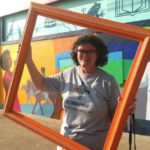 This Act Locally Waco blog post is by Ashley Bean Thornton, the Manager of the www.www.actlocallywaco.org website and the editor of the Friday Update newsletter. The Act Locally Waco blog publishes posts with a connection to these aspirations for Waco. If you are interested in writing for the Act Locally Waco Blog, please email ashleyt@actlocallywaco.org for more information.
This Act Locally Waco blog post is by Ashley Bean Thornton, the Manager of the www.www.actlocallywaco.org website and the editor of the Friday Update newsletter. The Act Locally Waco blog publishes posts with a connection to these aspirations for Waco. If you are interested in writing for the Act Locally Waco Blog, please email ashleyt@actlocallywaco.org for more information.
by James Karney
When I was a little boy in Bristol, Connecticut, one of my favorite toys was a well-worn set of Lincoln Logs that belonged to my older brothers. I would spend hours building cabins and forts out of the pieces; I can still feel the smooth texture of the logs and green roof slats in my hands. I’d play with the plastic frontiersman and animals creating stories and dialog; occasionally a GI Joe would make an appearance too. Those are great childhood memories, but what do building toys like Lincoln Logs and Legos and blocks have to do with the library?
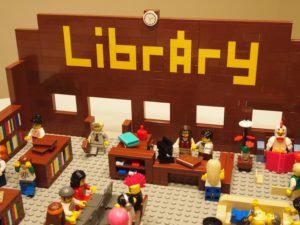 One role of the public library is to be a preschooler’s door to learning. As you already know, the library is a place children visit with parents and caregivers to be introduced to books and to begin to develop a love of reading, and learning. Library programs such as storytime help to develop school readiness skills such as listening, paying attention, following directions, and playing with other children. This, like many of the other programs and services of the library, folds into the one of the eight assumptions, of the Greater Waco Education Alliance. Participating in library storytime specifically addresses the first assumption, “Develop learning readiness and social skills before entering school (ages 0–4).” Storytimes for children are a staple of public libraries. At the Waco-McLennan County Library early childhood programming walks with children and parents from infancy with “Baby Time,” to “Toddle Time,” and then to “Pre-School Storytime.” (By the way, after a busy summer, Miss Vivian and Miss Stacy are taking a breather in August. Storytimes will resume the week of September 9th. )
One role of the public library is to be a preschooler’s door to learning. As you already know, the library is a place children visit with parents and caregivers to be introduced to books and to begin to develop a love of reading, and learning. Library programs such as storytime help to develop school readiness skills such as listening, paying attention, following directions, and playing with other children. This, like many of the other programs and services of the library, folds into the one of the eight assumptions, of the Greater Waco Education Alliance. Participating in library storytime specifically addresses the first assumption, “Develop learning readiness and social skills before entering school (ages 0–4).” Storytimes for children are a staple of public libraries. At the Waco-McLennan County Library early childhood programming walks with children and parents from infancy with “Baby Time,” to “Toddle Time,” and then to “Pre-School Storytime.” (By the way, after a busy summer, Miss Vivian and Miss Stacy are taking a breather in August. Storytimes will resume the week of September 9th. )
 Storytime is certainly an important stepping stone on the path to a love of learning, but at the library we recognize it is not the only stone in the path. In addition to weekly storytimes, the library offers other programming for children. Two programs we started last year have developed loyal and nearly overwhelming followings: a monthly “Lego Lab” for children 6-12, and a “Block Party” for Toddlers and Pre-K. Playing with blocks helps children develop motor, spatial, social and language skills and creative play. These skills are pretty obvious to anyone who has ever watched a toddler play and stack wooden blocks.
Storytime is certainly an important stepping stone on the path to a love of learning, but at the library we recognize it is not the only stone in the path. In addition to weekly storytimes, the library offers other programming for children. Two programs we started last year have developed loyal and nearly overwhelming followings: a monthly “Lego Lab” for children 6-12, and a “Block Party” for Toddlers and Pre-K. Playing with blocks helps children develop motor, spatial, social and language skills and creative play. These skills are pretty obvious to anyone who has ever watched a toddler play and stack wooden blocks.
Not so obvious are the long-term science, math and problem solving skills being developed. These skills support the third assumption of the Education Alliance, “Master math concepts (ages 9 to 17).” The research makes this connection plain:
• A longitudinal study by Wolfgang, Stannard and Jones found that beginning in the middle school years and onward through high school that there was a positive correlation between pre-school block play and mathematical achievement. (Journal of Research in Childhood Education, v15 n2 p173-80 Spring-Summer 2001)
• A 2009 article by Sarama and Clements explores the benefits of block and Lego play. (American Journal of Play p313-337 Winter 2009). At younger ages, pattern recognition, colors, shapes and counting are central to block and Lego play and with age come more complex skill development.
• For the differently abled, a 2006 study found that therapeutic play using Legos has a positive impact on social skill development of autistic children. (Autism, v10, n4 p317-29 July 2006).
In addition to the STEM (Science, Technology, Engineering and Math) benefits of block and Lego play, there are also language, literacy and social skills being developed. In group play with other children, a child learns about sharing and turn taking.
 Playing with blocks is a terrific way for parents to bond with their children and to act on their role as a child’s first teacher. Children get the most benefit from block play when parents and caregivers get on the floor and play alongside their children taking the opportunity to teach colors and counting, to compare block sizes and shapes, and perhaps most important of all, to share vocabulary with the child. Vocabulary development is a key to learning to read. The more children are exposed to new and different words, the more success they will have in learning to read and developing their reading skills. One of the best investments you can make in your child’s education is to spend time with them whether it is reading books, playing with Legos, or just talking with them. Hart and Risley found children’s academic successes at ages nine and ten are attributable to the amount of talk they hear from birth to age three. Meaningful Differences in the Everyday Experience of Young American Children. (Brookes Publishing 1995).
Playing with blocks is a terrific way for parents to bond with their children and to act on their role as a child’s first teacher. Children get the most benefit from block play when parents and caregivers get on the floor and play alongside their children taking the opportunity to teach colors and counting, to compare block sizes and shapes, and perhaps most important of all, to share vocabulary with the child. Vocabulary development is a key to learning to read. The more children are exposed to new and different words, the more success they will have in learning to read and developing their reading skills. One of the best investments you can make in your child’s education is to spend time with them whether it is reading books, playing with Legos, or just talking with them. Hart and Risley found children’s academic successes at ages nine and ten are attributable to the amount of talk they hear from birth to age three. Meaningful Differences in the Everyday Experience of Young American Children. (Brookes Publishing 1995).
The Library’s Lego Lab (Saturday) for children and toddler/Pre-K Block Party (Sunday) using Legos and blocks are held monthly. For days and times and to reserve a space for your child, visit the library’s online events calendar. The name Lego comes from the Danish phrase leg godt, which means “play well”, so come play well at the library and continue to Read, Waco, Read!
 This Act Locally Waco blog post is by James Karney. James has worked in a library since his sophomore year in high school and is the Director of the Waco-McLennan County Library. He enjoys reading biographies, history, and spy/espionage novels. He has been married to the super amazing and talented Anita Karney for 20 years, and their son Jamie will start his junior year of high school this year – yikes! Visit the Library’s website, www.wacolibrary.org to explore all of our services, program and resources and “Like Us” on Facebook at, www.facebook.com/WacoLibrary.
This Act Locally Waco blog post is by James Karney. James has worked in a library since his sophomore year in high school and is the Director of the Waco-McLennan County Library. He enjoys reading biographies, history, and spy/espionage novels. He has been married to the super amazing and talented Anita Karney for 20 years, and their son Jamie will start his junior year of high school this year – yikes! Visit the Library’s website, www.wacolibrary.org to explore all of our services, program and resources and “Like Us” on Facebook at, www.facebook.com/WacoLibrary.
If you would like to write a post for the Act Locally Waco blog, please contact Ashley Thornton by email at ashleyt@actlocallywaco.org .
by Sgt. W. Patrick Swanton, Waco Police Department
On August 1, we conducted our first “virtual ride-along” at the Waco Police Department, giving citizens a bird’s eye view of our world. The goal was to let you, our community, into our profession from the comfort of your home or wherever else you access your Facebook or Twitter accounts. We wanted citizens to see what the daily activities of a police officers’ shift might include and, man, they got that!!
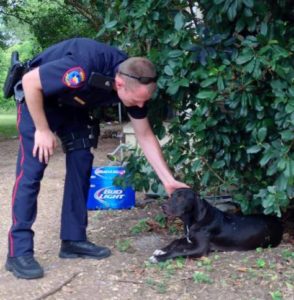 Those participating in the virtual ride-along started the day with an individual who had one too many margaritas and needed to visit one of our local emergency rooms. Then we introduced our K-9, Hondo, who discovered some crack cocaine in a vehicle. Then “riders” got to see the gentler side of policing when Officer Evans responded to a “Vicious Dog” call: The officer ended up a petting the dog, and the supposedly ferocious beast hopped into our squad for a ride to the Animal Services Center…wagging his tail along the way. And, there you have it! Our recent virtual-ride-along…This is just one of the things we would like to do on a consistent basis to get our citizens involved with us. (To see all the pictures from the virtual ride-along, click here: A night with Waco Police Department through a virtual ride-along.)
Those participating in the virtual ride-along started the day with an individual who had one too many margaritas and needed to visit one of our local emergency rooms. Then we introduced our K-9, Hondo, who discovered some crack cocaine in a vehicle. Then “riders” got to see the gentler side of policing when Officer Evans responded to a “Vicious Dog” call: The officer ended up a petting the dog, and the supposedly ferocious beast hopped into our squad for a ride to the Animal Services Center…wagging his tail along the way. And, there you have it! Our recent virtual-ride-along…This is just one of the things we would like to do on a consistent basis to get our citizens involved with us. (To see all the pictures from the virtual ride-along, click here: A night with Waco Police Department through a virtual ride-along.)
If you virtually followed along with Assistant Chief Holt and me that Friday, you hopefully became more aware of what and how we conduct business. I tried to put a bit of personality with the badges to show you that, yes, we are actually human! We can pet a dog, grab a bite to eat, and give a kid a break on his birthday. We can deal with the humdrum of the paperwork, and then switch gears with a moment’s notice to rush to the scene of an injury accident, or to put a drug addict in jail. It’s all part of what we do.
We police are at times a strange and distant lot. We don’t often show much personality when we deal with the public. Much of this is due to the simple reason that our jobs can change so quickly. As a police officer you can go from changing a light bulb because your dispatchers sent you to a recently widowed “she’s our Mom type” who was afraid to go out after dark, to the next minute standing in an alley spitting out your teeth because some thug sucker-punched you in the face because he didn’t want to go back to jail. YES!!! It can all change that quickly.
We don’t often ask for the public’s sympathy and that’s because we know…NO ONE made us sign up for this job. It was a conscious choice to become a Police Officer and one that if given the opportunity — even though we know the good and bad — most of us would make again.
Policing is a life choice. Once you are in, you become part of something much bigger than any “one” of us. You are a part of something that has stood the test of many years, protests and naysayers. We do what we do best, and that is to protect and serve our community.
We Waco Police are fortunate to serve in Waco where we have a good relationship with our community. No, it’s not always perfect, and it is something that will always need constant attention. However, Chief Stroman believes that continuing to be transparent and open about “your” Police Department is one of the best ways to foster a positive and trusting relationship with our citizens. So stay with us, be a part of us and this community, be proud of YOUR Waco Police Department and the City of Waco, and as one of our commentators from the Friday night virtual ride-along said, “Put on the Popcorn!!” In other words, stay tuned as there is more to come!!….”One Adam 12…One Adam 12… see the man at……”
 This week’s Blog was written by Sgt. W. Patrick Swanton, Spokesman for Waco Police Department. (Facebook: WacoPoliceDepartment; Twitter: WacoPolice). If you are interested in writing for the Act Locally Waco blog, please email AshleyT@actlocallywaco.org
This week’s Blog was written by Sgt. W. Patrick Swanton, Spokesman for Waco Police Department. (Facebook: WacoPoliceDepartment; Twitter: WacoPolice). If you are interested in writing for the Act Locally Waco blog, please email AshleyT@actlocallywaco.org
by Anna Dunbar
I often wonder why we don’t have more people participating in curbside recycling in Waco. We have about one-third of our Waco households participating in the blue cart recycling program now, but why don’t more households participate? After all, participation is pretty easy and it is available with no extra fee! We even have a recycling drop-off center that accepts recyclables from those who do not have easy access to curbside recycling service. Let me explain:
Curbside recycling is available at no extra charge!
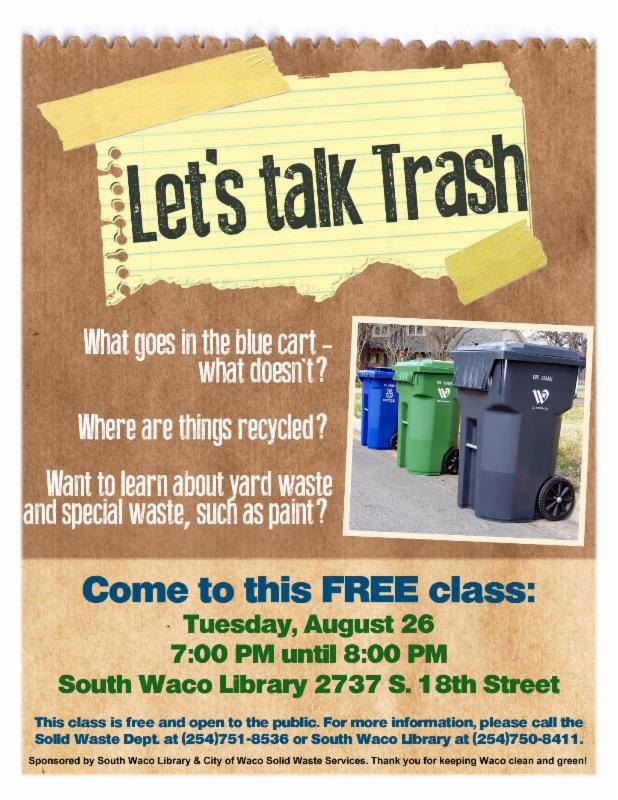 If you are a Waco resident with Waco trash service with a grey trash cart, you can have curbside recycling at no extra charge. Put all recyclables together in your blue curbside recycling cart:
If you are a Waco resident with Waco trash service with a grey trash cart, you can have curbside recycling at no extra charge. Put all recyclables together in your blue curbside recycling cart:
A. Any paper that is clean and will tear.
B. Metals such as aluminum cans, aluminum baking tins, steel (tin) food cans and lids. No need to rinse soda cans unless you just want to (ants!), please do rinse food cans.
C. Plastics, all colors, numbers 1 thru 7 and plastic bags.
D. Please do not put glass or Styrofoam into your recycling cart. Glass of all colors may be taken to the Cobbs Recycling Center located on 44th Street between Cobbs Drive and Trice Avenue. For more information, call (254) 751-8536 or go to waco-texas.com.
Recycling is not hard!
The City of Waco has made it pretty simple. You put all recyclables in one blue cart, loose. The blue cart system is intended to be hassle free, no sorting! If you are new to recycling, you do not have to recycle everything possible, just start with a couple of categories. For example, if your household has magazines, cardboard and newspaper, start with that! Later you can add water bottles, soft drink bottles and aluminum cans such as soda cans. Those items require minimal preparation for recycling, and everyone knows what they are, cutting down on decisions and confusion. Your recycling day is the same day as your trash day, but every other week. If you do not remember which week to set out your blue recycling cart, go to Waco-texas.com or call (254) 299-2612 for a solid waste and recycling calendar. Or if your neighbors recycle at curbside, copy what they do!
It’s easy to get a blue cart!
If you do not have a blue recycling cart, you can pick one up at the Cobbs Recycling Center, 2021 44th Street, or the Operations Center, 501 Schroeder Drive. Please bring your water bill and proof of Waco residency. If you are unable to pick up your cart, please call (254) 299-2612 to request delivery of the cart.
Still think it’s not worth it?
Think again! Your reduced waste can make a difference for the environment and for our landfill. If every Waco household recycled everything they could, it would make such a great impact on the amount of waste going to our landfill! It is estimated that about 50% of the trash we generate in the US is recyclable. That is important because it is estimated that the Waco landfill has a remaining life of just twelve years. What that means is that Waco will have to expand the landfill within the next twelve years in order to contain our ever increasing “mountain of trash”! I think we all want to save landfill space because doing so delays the expenditure of money to expand our landfill.
Come on, Wacoans, join me in keeping Waco Clean and Green!
 This week’s Act Locally Waco blog post is by Anna Dunbar. Anna is the Recycling and Public Outreach Administrator for the City of Waco Solid Waste Services. She is responsible for informing Waco residents and businesses about recycling and waste reduction opportunities as well as solid waste services in Waco. Her husband is a Baylor professor and her daughter is a senior at Trinity University. She serves on board of Keep Waco Beautiful and is a member of The Central Texas Audubon Society and Northwest Waco Rotary. If you would be interested in writing for the Act Locally Waco blog, please email ashleyt@actlocallywaco.org .
This week’s Act Locally Waco blog post is by Anna Dunbar. Anna is the Recycling and Public Outreach Administrator for the City of Waco Solid Waste Services. She is responsible for informing Waco residents and businesses about recycling and waste reduction opportunities as well as solid waste services in Waco. Her husband is a Baylor professor and her daughter is a senior at Trinity University. She serves on board of Keep Waco Beautiful and is a member of The Central Texas Audubon Society and Northwest Waco Rotary. If you would be interested in writing for the Act Locally Waco blog, please email ashleyt@actlocallywaco.org .



